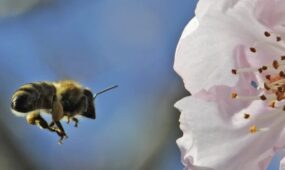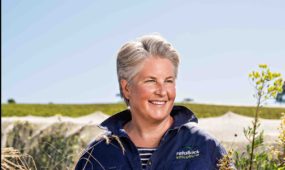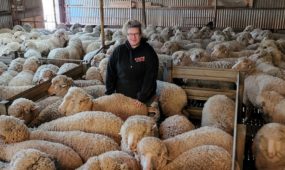New technology beefs up the appeal of IVF in cattle industry
Primary Industries
A new suite of media formulations to improve livestock reproduction could be the tipping point away from artificial insemination and towards cattle IVF processes that can quickly build the quality and size of global herds.

Sign up to receive notifications about new stories in this category.
Thank you for subscribing to story notifications.
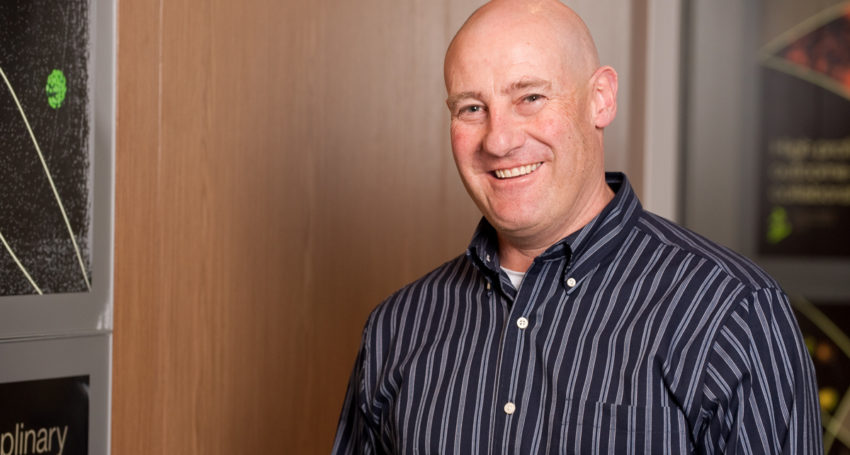
ART Lab Solutions was formed in South Australia in November 2017 and launched its first product range at the International Embryo Technology Society meeting in Thailand this month.
It builds on decades of research into assisted reproductive technologies (ART) by Professor Jeremy Thompson, a reproductive health expert from the University of Adelaide’s Robinson Research Institute.
Cattle IVF provides greater flexibility in rapid genetic improvement than currently accepted processes, such as artificial insemination (AI) or hormone-mediated multiple ovulation-embryo transfer. It can even select the sex of the calf, which could be of significant benefit to the dairy industry.
Typically, using IVF, breeders aim to produce 5-6 calves per procedure, in addition to the donor cow calving. This gives the potential for much faster herd growth while maintaining high genetic quality.
Sexed semen can also be used more efficiently in IVF processes, as one semen straw can be used to fertilise a number of eggs in IVF compared to one semen straw per cow for AI.
However, cattle IVF has traditionally achieved lower pregnancy rates than these other options, resulting in limited industry uptake.
Working with its partner, Australian Reproductive Technologies, and in collaboration with other researchers at the University of Adelaide, research by ART Lab Solutions has resulted in significant advances in formulation performance.
“We have proven that, comparing results using other media, we see a lift in pregnancy rates of at least 10 per cent using our products,” ART Lab Solutions founder Professor Thompson said.
“We can improve these results even further with our latest research insights and we expect to be able to use these more effective solutions commercially over the coming year.”
The media suite, which includes six base formulations, enables the development of large numbers of unfertilised eggs that are recovered from cows with high genetic merit.
“These eggs are then fertilised, and develop to seven-day-old embryos in the laboratory, which can then either be transferred into less valuable recipient cattle, or cryopreserved for transfer at a later time,” Professor Thompson said.
“IVF cattle embryo development provides far more options for rapid genetic selection, to improve livestock production and health, with potential benefit to both beef and dairy farmers.
“Around the world cattle IVF has been booming, with more than 600,000 cattle IVF embryos produced each year. But the industry is comparatively small in Australia and South-East Asia, partly as there has been no consistent supplier of a proven media product.”
IVF process – click here for larger image
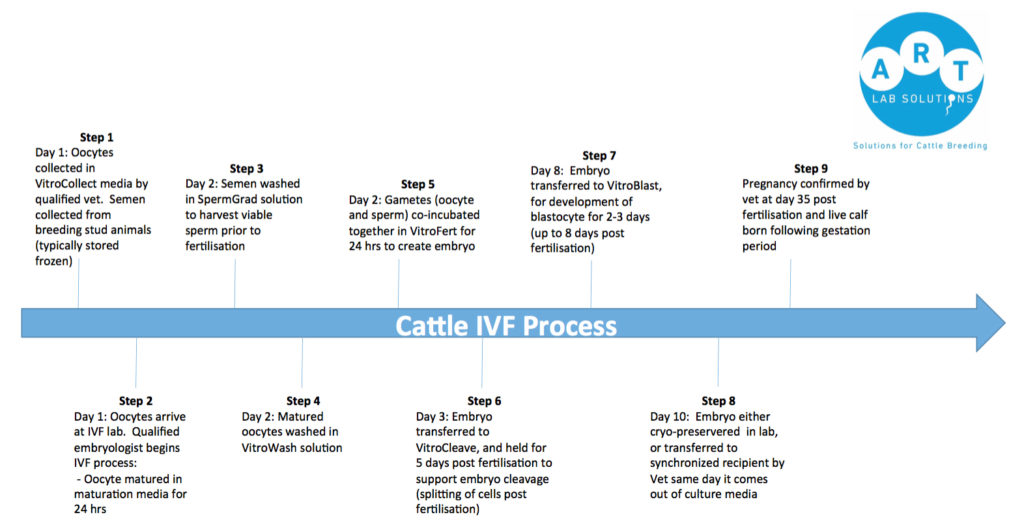
Queensland-based Australian Reproductive Technologies is a shareholder in the business along with Professor Thompson and The University of Adelaide. It has played a key role with in-field validation of the technology throughout the pregnancy and birthing processes.
The relationship started more than eight years ago when Australian Reproductive Technologies was a customer of what was then a division of the university.
ART Lab Solutions company director Kirsten Bernhardt said that long relationship meant a lot of R&D and product testing had been done well ahead of this month’s product launch.
She said although AI and other similar technologies had the lion share of the market currently, the high value of the beef industry, the need to grow the herd quickly and improvements in technology had created an opportunity for IVF.
“The timing feels really right at the moment with the things that we are seeing in livestock herd trends and demand so the window of opportunity is there to get in and grow IVF on the whole globally,” Bernhardt, who is also Commercial Manager at University of Adelaide Enterprise said.
“We’re really excited about the 10 per cent lead in pregnancy rates.
“Our measure is two-fold, we look at fertilisation rates – the number converted into embryos in the lab – and also the number of embryos converted into pregnancies and we believe we are above current industry standards on both of those, giving it global potential.”
ART Lab Solutions is also offering training courses to grow the skills base among commercial operators needed to support a growing IVF industry.
Bernhardt said although the main customers in Australia and globally for the new media suite would likely be cattle reproductive businesses and breeders, large livestock producers would also be key stakeholders.
“We don’t envisage that we will have a direct customer relationship with the livestock producers but they are such a key stakeholder for us so part of our strategy is to engage with them so that the larger producers start asking their breeders for Jeremy’s technology,” she said.
“We think we’ll be able to achieve market share from existing competitors but really the big opportunity is positioning the business to encourage vets and producers to convert from AI to IVF technology because that’s a whole subset of the market that is essentially untapped.
“If we can get in as the market leader in IVF then as the industry moves from AI into IVF we will be well positioned to pick up that growth.”
ART lab Solutions is also working to develop a smartphone-based sperm analyser in collaboration with RMIT University’s optical physicists and University of Adelaide’s reproductive biologists.
Currently in prototype phase, the cost-effective device can clip on to any smartphone and aims to transform cattle sperm analysis.
Bernhardt said while the prototype device measured sperm motility well, morphology measures were being added to give it the ability to almost instantaneously rate a bull’s reproductive potential in the field.
She said the sperm analyser would help reduce costs and further improve cattle IVF pregnancy rates.
“If you think about the costs that saves compared to bringing sperm back to the lab, fertilising with lower grade sperm and not getting a viable embryo then that is a lot of wasted time and product to go through that process,” Bernhardt said.
“So if we can identify those higher potential bulls earlier that will really help.”
Jump to next article
